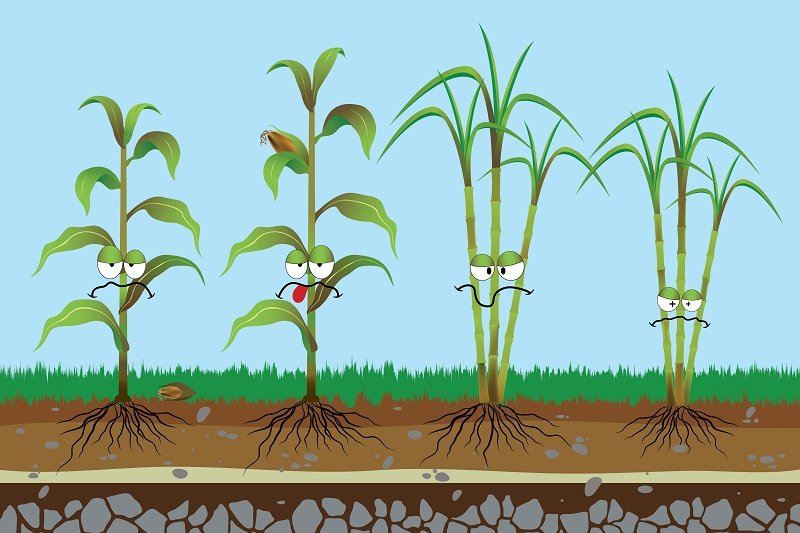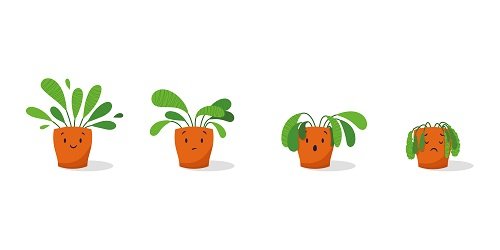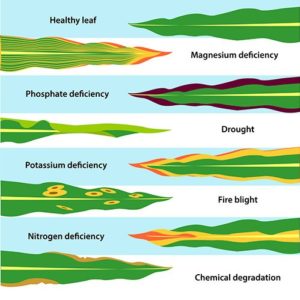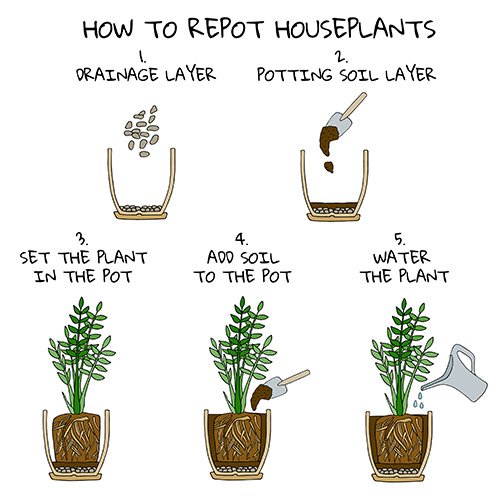Water is essential for all forms of life on this planet. Our plants, especially, need water to grow. Which leads many people to think that giving your container plants a little extra water, it can only make things better. Unfortunately, overwatering indoor plants and container plants is one of the biggest issues plant owners face. Too little water and your plants die. And too much water and your plants can also die. Too much water in the growing media can lead to adverse growing conditions, with root rot being the worst. It is a silent killer for pot plants and can reach fatal stages before gardeners even notice. Today we’re going to discuss what root rot is, how to identify it, how to treat and how to prevent this plant killer.

What is Root Rot?
Root rot is the decay and rot of plant roots caused by a lack of oxygen in the substrate. And, just like human, submerging roots in too much water and too little oxygen can cause them to suffocate and drown. Low oxygen levels also trigger the overgrowth and spread of fungi that naturally occur in the soil. Once these fungi start to grow they move into the weakened roots, infecting your plants. Once the roots become infected, they begin to die and are unable to take in oxygen, water, and the nutrients needed for growth. This causes the plant to quickly die.
How to Identify Root Rot
Unfortunately, when root rot begins to affect your plants, it can look like other plant diseases. This is because the symptoms of root rot can look like the symptoms of other diseases and conditions.

Wilting
One of the biggest reasons people over water is wilting leaves. Plants that are overwatered can wilt just like plants that are underwatered. Plant owners end up giving their plants too much water to combat the wilting, resulting in too much water in the soil that drowns the plants. This, in turn, exacerbates root rot.

Nutrient Deficiency
Root rot can also be mistaken for nutrient deficiency. They check the soil and it is wet to touch, that it’s getting enough sunlight, and there is no sign of pest issues, it can be natural to assume the issue is a lack of nutrients. This results in an unfortunate issue when plant owners decide to use a water-soluble fertiliser. These fertilisers are mixed into water and added to the soil. This added water exacerbates the already waterlogged soil and increases the root rot issue.
Root rot can be identified by soft, brown roots. The root system of a healthy plant should be firm and white. Roots turn brown when the soil turns soggy and the fungus starts to multiply and spread. It starts in the outer areas of the roots first and as the fungus advances, the healthy roots turn brown, mushy and die.
From here, the leaves begin to wilt, yellow, and fall off. Growth slows and blooming is delayed. In the most extreme cases, plants can die within ten days.
Is Root Rot Contagious?
Unfortunately, root rot can be transferred from one plant to another. The fungal spores can become airborne, and even transported by insects and dirty gardening tools, to infect other plants. Garden plants are actually more susceptible to the transfer of fungal spores from one plant to another because they are in closer proximity than container plants. Further, the increased air movement outdoors is perfect for spreading spores and insects from plant to plant. Indoor plants spread root rot less easily and less frequently, but it can still happen. Especially if you are overwatering your plants.

What About Root Rot in Hydroponics?
Hydroponics focuses on growing plants with the roots entirely in water, with no soil. So how do these plants not constantly succumb to root rot? The truth is that root rot is still an issue in hydroponically grown plants and growers must be constantly on the lookout. In hydroponics focus on nutrient solutions being fed to plants, resulting in a constant movement of water through the root zone of the plants. This encourages the oxygenation of the roots. It is when water is left stagnant and the oxygen is depleted from it, the plants begin to experience root rot similar to when plants are grown in soil.
How to Deal with Root Rot
Once you’ve identified your plant has root rot, you need to determine if the plant can be saved. If the entire root system is brown and mushy, it is too late to save the plant. If some healthy, white, firm roots are still part of the root system, you can try to bring the plant back to life. Prepare to replant by cleaning the roots gently under running water and remove all the brown, mushy roots with a sharp pair of scissors. Cut the healthy roots just above the damaged area. After all the roots are pruned back, sterilise the scissors with a solution of one part bleach to three parts water to avoid spreading fungal spores. Quickly replant the plant in fresh soil.
You can also attempt to dissect the non-infected parts of the plant from the infected parts with sterilised cutting tools. These healthy parts can be also transferred to fresh soil.
You can also add a root treatment o the plant. This root treatment should contain beneficial mycorrhizal species. You can also dust the healthy roots with sulphur powder or cinnamon. These are natural fungicide to help prevent reinfection. These solutions create a hostile environment for unwanted bacteria and fungi, killing them before they can infect your plants. Sulphur also acts to acidifying the soil, making certain nutrients less available. This means you are limiting the fungus’ food source.
A final option to try to save a plant that is close to succumbing to root rot is take a stem or leaf cutting from the healthy foliage and attempt to propagate a new plant.

How to Prevent Root Rot
One of the best measures to protect your plants is knowing how to prevent root rot. Prevention is always the best measure. We have the following recommendations to help prevent root rot in your indoor and outdoor plants.
Soil
Good drainage is key to preventing root rot, as well as maintaining an appropriate ratio of water and oxygen in the roots. You should always use the right growing media for your plant. Regular garden soil is not going to work well for indoor plants as it compacts too easily in containers. This pushes all the oxygen out of the root zone. Other plants simply cannot survive in soils and need more specialised mixes, like peat moss, perlite, coconut coir, and vermiculite.
Drainage
You should ensure your indoor and container plants have drainage holes in the bottom of their containers. If a pot doesn’t have them, you can add drainage holes yourself with a power drill. Be careful you use a masonry drill bit when it comes to terra cotta and clay pots or you will risk cracking them.
However, sometimes you have no choice but to use a container that doesn’t have any drainage holes or holes can’t be added. In such a case, you need to create what is called a cachepot to allow drainage. This means potting the plant in a container (with good drainage) that’s a little bit smaller than the non-drainage pot. Place something on the bottom of the bigger container – stones are a great option – and place the smaller on inside. The space between the bottoms of the two pots allows the smaller one to drain into the larger, preventing the build up of water among the roots.
If you use a saucer or catch basin under the container to collect excess water, make sure to empty the saucer every time you water your plants. Never leave your plants to sit in standing water.
Don’t line the bottom of your pot plants, drainage or not, with rocks or pebbles to create a drainage layer. Rather than encouraging drainage, it can actually inhibit it. As the water moves downward, it will slow or even stop moving when it reaches the rock or small stone layer. This is different from a cachepot that is merely catching water after it is already drained from the soil.
Watering Appropriately
Finally, knowing how to water each of your plants appropriately is the best way to prevent root rot. Research the best ways to water your plants. For mean, this means letting the top of the growing media dry out before you water the plant again. Knowing how to properly water each plant is especially important in Winter months when plants are dormant and growth naturally slows.
Aumann’s Garden Supplies carries a wide range of pots, planting containers and indoor plants to suit your needs. Explore our range online, today, or come in store to find the perfect addition to your garden!

